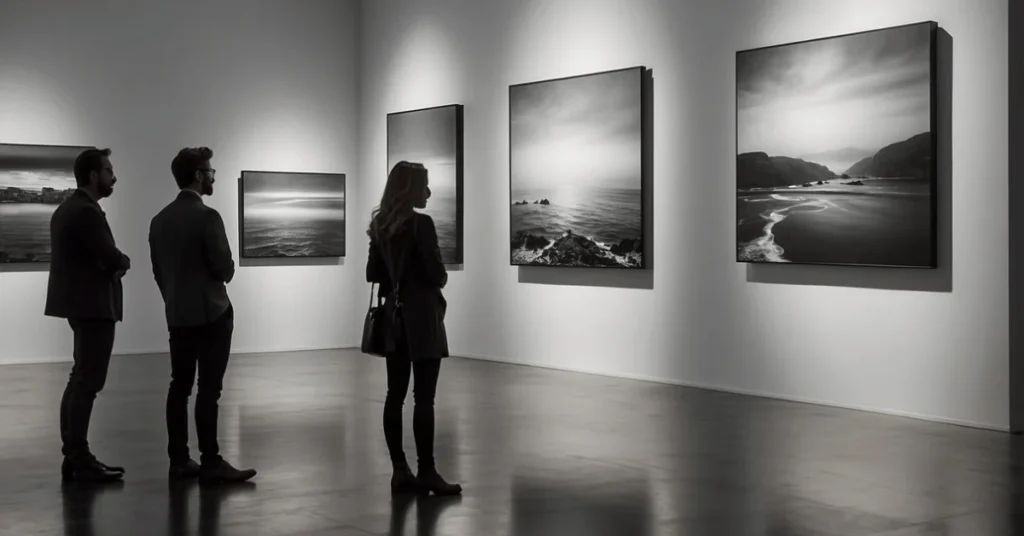As aficionados of fine art, we often explore different movements that leave indelible marks on the canvas of history.
The realm of the most famous minimalist art presents itself as an intriguing subject that beckons us to appreciate the beauty in simplicity. It is here, within the stark confines of minimalism, that the adage ‘less is more’ truly finds its resonance. These artworks forego the superfluous, encouraging us to focus on the essential elements of composition and form.
Minimalism emerged as a significant movement in the post-war Western art scene, contrasting the expressive works of Abstract Expressionism. It championed an aesthetic that stripped art down to its fundamental features, focusing heavily on order, simplicity, and harmony. The movement’s influence extended beyond the visual arts, affecting design, architecture, and music, demonstrating the versatility and enduring legacy of its key principles.
Key Takeaways
- Most famous Minimalist art emphasizes simplicity and order, contributing to its timeless appeal.
- The movement has influenced various forms of creative expression, from visual arts to architecture.
- Renowned minimalist artists and their works continue to fascinate and inspire art enthusiasts around the world.
Origins and Historical Context of the most famous minimalist art
In the bustling era of the 1960s, a pivotal art movement took shape within the heart of New York. As we examine the emergence of the most famous minimalist art, it’s essential to acknowledge its distinction from the emotionally charged canvases of abstract expressionism that dominated the 1950s. Minimalism, by contrast, was a clear departure marked by an ethos of simplicity.
- Minimalism:
- Emphasis on simplicity
- Use of geometric forms
- Lack of personal expression
Artists in the minimalist movement stripped their work to its most fundamental features, often employing monochromatic color schemes and simple, geometric structures. They sought to remove the narrative, the extraneous decorations, and the artist’s hand as much as possible.
We observe that this reductive approach was not purely a Western phenomenon; it bore connections to Zen Buddhismand Asian art philosophies, infusing a global context to the movement’s essence. These minimalist tendencies didn’t emerge in isolation but were a sophisticated response to the complexity of prior art forms and societal changes.
Here’s a brief chronology to ground our understanding:
- Precedents in the early 20th Century: The seeds of minimalism were sown with the abstract works of artists like Kasimir Malevich.
- Expansion in the 1960s: In the bold wave of the ’60s, artists consciously moved away from expressionism seeking purity in art.
- Consolidation as a Movement: The most famous minimalist art solidified as a named movement, encapsulating the philosophy of ‘less is more’ into a formal art practice.
Key Principles and Characteristics

As we explore the stripped-down aesthetic of minimalism, let’s recognize its profound impact on the visual language of our times. Not a mere style but a philosophy, minimalism urges us to focus on the essence of form and expression.
Concept of Minimalism
Minimalism is an art movement characterized by a deliberate lack of decoration, emphasizing the use of simple geometric forms and monochromatic palettes. The aim is to strip everything down to its fundamental aspects, allowing the artwork to stand on its own without complex representations or narratives. This purity of design often results in art that engages viewers in a conceptual art experience, directing them to contemplate the work’s intrinsic properties such as shape, color, and medium. True minimalism in art is about making each element meaningful—every line, texture, and space involved is intentional and necessary.
Influence on Design and Architecture
In design and architecture, minimalism manifests as clean lines, open spaces, and functional simplicity. This approach rejects the ornate embellishments of previous stylistic periods and leans towards practicability and clarity of structure. Minimalist design considers every aspect from form to function, resulting in environments that breathe and live with those who inhabit them. Similarly, minimalist architecture is hallmarked by the integration of space and light, creating harmonious buildings that resonate with the rhythm of daily life while emphasizing the beauty of unadorned simplicity.
Our Picks of the Most Notable Artists and Works

Our journey through minimalism unveils a constellation of influential creators whose stark works challenge and captivate. We’ve handpicked the most significant artists and their paradigm-shifting pieces for a concise exploration of minimalist mastery.
Frank Stella
Frank Stella, a painter who advanced the minimalist dialogue, is renowned for his series of Black Paintings. In his hallmark work, Die Fahne Hoch!, Stella strips away illusionism to deliver raw, material presence.
Sol LeWitt
As for Sol LeWitt, his impact as a sculptor and painter reverberates through his commanding concepts. His creations, such as Untitled, highlight the essence of forms, guided by a radical approach that lays bare the generative process of art itself.
Donald Judd
We note Donald Judd, whose distinct approach to three-dimensional works establishes him as a key figure in the most famous minimalist art. His emphasis on the object’s autonomy is exemplified in the assertive simplicity of pieces like Untitled, crafted from industrial materials such as lead.
Carl Andre
With Carl Andre, minimalism treads on new terrain. Andre’s tactile floor pieces, like Lever, constructed in the early 1970s, underscore the floor as a critical display area, prompting viewers to reconceive space and form relationships with the environment.
Dan Flavin
Lastly, Dan Flavin illuminates minimalism’s scope through fixtures of light. His work focuses on fluorescent light, offering an ethereal encounter, where the medium diffuses beyond physical boundaries, transforming the surrounding space into the substance of the artwork itself.
Mediums and Techniques

In the realm of minimalist art, we witness a profound expression of simplicity and precision. Our focus here is on the distinct mediums and techniques that exemplify the minimalist movement, ensuring that every brush stroke or chiseled corner encapsulates the essence of minimalism.
Painting and Sculpture
Minimalist painting strips down to basics, often utilizing monochromatic palettes and geometric forms. Paintings are typically made with oil on canvas, emphasizing flatness and abstract visual elements. Sculptures, by contrast, bring the clean lines and industrial materials like metal, glass, or concrete into three-dimensional space. They challenge our perception, urging us to consider the relationship between the artwork and its environment.
Drawing and Printmaking
In drawing, minimalist artists use simplicity and economy of line, where minimal marks on paper could convey maximum impact. Printmaking, on the other hand, allows the replication of these simple forms, extending the reach of minimalist concepts within the visual arts to a wider audience.
Installations and Land Art
Installations in the minimalist context transform spaces into sites of sensory experience, using simple, repetitive elements to compose a serene atmosphere. Meanwhile, Land Art integrates the natural landscape with man-made interventions, drawing attention to the vastness of space and material presence—each installation rooted in the minimalist ethos of reduction and refinement.
Our Thoughts on Influence and Legacy

Minimalist art, emerging predominantly in the USA and Japan, has stripped back the superfluous and emphasized the essential in a way that has had profound implications across various forms of expression. As aficionados observing the waves this movement has made, we note its pivotal role not just in visual arts but also in shaping the contours of music, fashion, literature, and beyond.
Impact on Contemporary Art
Minimalist art, with its emphasis on simplified forms, has left an indelible mark on contemporary art. The core principles of minimizing detail to expose the essence of a subject have encouraged artists to focus on elements such as geometry and spatial relationships. Consequently, urban art installations have evolved, moving towards experiences that prompt introspection and a distilled emotional engagement from the audience.
Minimalism’s influence extends to movements like land art, where the simplicity and the vastness of geographical forms interact. Exhibitions at prestigious institutions, like the Museum of Modern Art, often display the most famous minimalist art, highlighting its standing within the art community and its legacy as an enduring staple.
Minimalism Beyond Visual Art
Shifting our gaze from the gallery walls, we discover minimalism’s resonance beyond the visual spectrum. In music, the repetition and reduction approach taken is sometimes reminiscent of the repetition found in a minimalist canvas. Our closets, influenced by minimal fashion, have seen an influx of designs favoring clean lines and understated elegance. And in literature, you’ll find narratives favoring the weight of succinct, powerful prose, leaving the surplus to the reader’s imagination.
The most famous minimalist art movement is more than a style; it has become a pervasive part of our cultural fabric, influencing how we express, perceive, and feel within a myriad of contexts.
Critical Reception and Interpretation

When we explore the most famous minimalist art, we’re delving into a realm where simplicity speaks volumes and every element is loaded with meaning. The conversation around this movement touches on profound ideas about expression, beauty, and representation.
Academic Perspectives
Academic perspectives on minimalist art often emphasize its radical break from previous art movements. This school of art reduces the form to its bare essentials, often utilizing geometric structures and monochromatic color schemes. It’s an approach where the intrinsic beauty of the form and material takes precedence. Critics from the academic world have dissected this movement, linking it to notions of purity and objectivity in art. They’ve seen it as a response to the complexities of abstract art, stripping down emotion and personal expression to seek a universal language in simplicity.
Public Perception
In contrast, the general public has had varying perceptions of the most famous minimalist art. To many, the stark simplicity of these artworks can be simultaneously intriguing and challenging. This genre’s focus on basic shapes and limited color can either evoke profound emotion or leave viewers searching for meaning within the restrained expressions of the artists. Over time, the public has become more receptive to the idea that less can indeed be more, finding beauty and resonance in the spaces and silences that minimalist art provides.
Frequently Asked Questions

In the realm of art, minimalism is an influential movement we often encounter. With its stark simplicity and profound impact, this style has captivated audiences and reshaped our understanding of artistic expression. Let’s answer some of the most common inquiries concerning this significant artistic phenomenon.
Who are the most recognized modern most famous minimal art?
Several modern artists have made a substantial impact on the minimalist scene, but Donald Judd and Frank Stella are particularly notable. Their work embodies the movement’s emphasis on simplicity and form.
Which most famous minimalist art is considered the most influential?
The most influential minimalist artwork is often debated, but many point to Donald Judd’s “Untitled” series of box-like structures as a foundational example that continues to inspire contemporary artists.
What are some iconic examples of minimalist art?
Iconic examples of the most famous minimalist art include Frank Stella’s Black Paintings and Agnes Martin’s grid-like paintings that evoke a sense of serenity and introspection.
Who is a notable minimalist printmaker?
Bridget Riley is a notable artist associated with minimalism and is particularly well-known for her op art prints, which focus on the interaction between simple forms and the visual effects they create.
How has minimalist art evolved over time?
The most famous minimalist art has evolved from its initial focus on industrial materials and geometric forms to include site-specific installations and digital art, reflecting changing technologies and sensibilities.
Can Mark Rothko’s work be classified as minimalist art?
While Mark Rothko’s paintings are not typically classified as minimalist due to their emotive use of color, his work does share the movement’s emphasis on simplicity and form. His pieces lent inspiration to later minimalist artists.
We’ve delved into the world of the most famous minimalist art, but your perspective matters too! Do you have favorite pieces or artists that inspire your minimalist aesthetic? Share your thoughts and join the conversation below!


